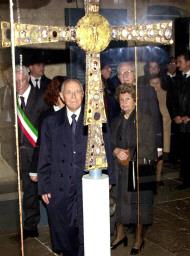A group of Italian MPs on Thursday asked for government backing in a bid to add Italy's trove of Lombard architecture to UNESCO's World Heritage list.
The multi-site bid, which includes seven achievements of Italian Lombard culture, was launched in January by the last government's minister for culture, Francesco Rutelli.
Ten MPs appealed to new Culture Minister Sandro Bondi to confirm government support for the idea.
''Given the strategic significance of the initiative for the local councils, the regions involved and for the whole country, a government commitment is crucial to support this important project, which would add extraordinary value to the chosen sites,'' said the Democratic Party's Constantino Boffa.
The seven sites chosen to represent Lombard culture include the Santa Giulia monastery in Brescia, a fort and tower at Castelseprio near Varese and a collection of restored ruins at Cividale, Friuli, the first Lombard city in Italy.
These three sites, all in northern Italy, are joined by two in Umbria: the church of San Salvatore at Spoleto and the nearby Tempietto ('little temple') at the Campello beauty spot.
The list is rounded off by the well-preserved church of Santa Sofia in Benevento east of Naples and the shrine of St Michael at Monte Sant'Angelo near Foggia on the heel of Italy's boot.
The Lombards, or Longobards, swept down to conquer Byzantine Italy in the fourth century AD.
From their base in present-day Lombardy they extended their sway over the whole country until they were in turn conquered by the Franks in the eight century AD.
Originally a pagan tribe, they became staunch defenders of Christianity and a bulwark of the Church in the Dark Ages.
Among the beacons they preserved for posterity was Bobbio Abbey near Piacenza, once the home of a fabled library.
It was the model for the monastery in Umberto Eco's novel The Name of the Rose.
Italy pulled ahead of Spain on UNESCO's roll of honour when its 41st heritage site, Genoa's historic Rolli network of palazzi, was honoured in 2006.









